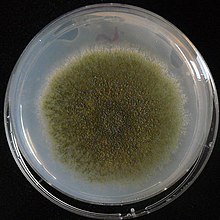| Aspergillus nidulans | |
|---|---|

| |
| A. nidulans with wild-type green spores, grown under laboratory conditions. | |
| Scientific classification | |
| Domain: | Eukaryota |
| Kingdom: | Fungi |
| Division: | Ascomycota |
| Class: | Eurotiomycetes |
| Order: | Eurotiales |
| Family: | Aspergillaceae |
| Genus: | Aspergillus |
| Species: | A. nidulans
|
| Binomial name | |
| Aspergillus nidulans G Winter 1884
| |
| Synonyms | |
|
Emericella nidulans | |
Aspergillus nidulans (also called Emericella nidulans when referring to its sexual form, or teleomorph) is one of many species of filamentous fungi in the phylum Ascomycota. It has been an important research organism for studying eukaryotic cell biology[1] for over 50 years,[2] being used to study a wide range of subjects including recombination, DNA repair, mutation, cell cycle control, tubulin, chromatin, nucleokinesis, pathogenesis, metabolism,[3] and experimental evolution.[4] It is one of the few species in its genus able to form sexual spores through meiosis, allowing crossing of strains in the laboratory. A. nidulans is a homothallic fungus, meaning it is able to self-fertilize and form fruiting bodies in the absence of a mating partner. It has septate hyphae with a woolly colony texture and white mycelia. The green colour of wild-type colonies is due to pigmentation of the spores, while mutations in the pigmentation pathway can produce other spore colours.
- ^ Osmani SA, Mirabito PM (2004). "The early impact of genetics on our understanding of cell cycle regulation in Aspergillus nidulans". Fungal Genet Biol. 41 (4): 401–10. doi:10.1016/j.fgb.2003.11.009. PMID 14998523.
- ^ Martinelli, S. D.; J. R. Kinghorn (1994). Aspergillus: 50 years on. Elsevier. ISBN 978-0-444-81762-4.
- ^ Nierman WC, May G, Kim HS, Anderson MJ, Chen D, Denning DW (2005). "What the Aspergillus genomes have told us". Med Mycol. 43. Suppl 1 (s1): S3–5. doi:10.1080/13693780400029049. PMID 16110785.
- ^ Schoustra SE, Slakhorst, M, Debets, AJM, Hoekstra, RF (2005). "Comparing artificial and natural selection in rate of adaptation to genetic stress in Aspergillus nidulans". J Evol Biol. 18 (4): 771–778. CiteSeerX 10.1.1.535.8579. doi:10.1111/j.1420-9101.2005.00934.x. PMID 16033548. S2CID 9909073.